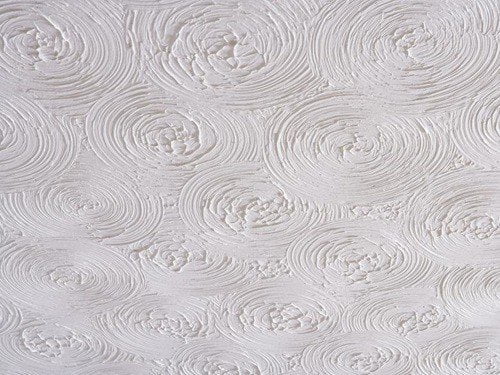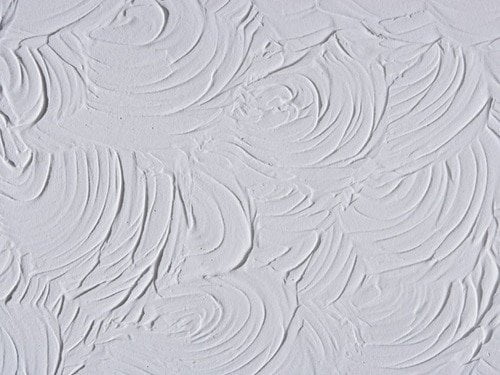Artex Removal
Artex is a water-based decorative coating used to create textured patterns on ceilings and walls. Artexing was extremely popular throughout the 1970’s, but it has become less prominent in recent years, resulting in an increase in artex removal. Unfortunately, artex often contained asbestos, which is extremely dangerous.
Nowadays, artex removal is often more common than artex installation. If you have moved into an older house that contains artex ceilings or walls, or simply want to modernise your home, removing artex is a quick and affordable process.
Artex Containing Asbestos
A popular reason homeowners remove artex is due to the risk of asbestos. Asbestos was a common additive in artex, as well as many other building products, due to the strengthening and fire resistance properties it adds. However, it is now known that asbestos fibres are extremely dangerous and can cause a number of diseases.
How do you know if my Artex contains Asbestos?
Asbestos was commonly added to artex until the mid 1980’s, but the use of asbestos was not banned until 1999. As such, an artex ceiling or wall installed prior to the year 2000 may contain asbestos. Patterned plaster and artex installed post-2000 should be asbestos-free.
Artex that was installed prior to 1999 could contain asbestos. Asbestos is not easy to identify, and requires specialist laboratory testing to confirm its presence. A professional asbestos survey and testing service can be used, or if it is safe to do so, you can also send a sample of your artex to a testing lab yourself.
If you recently purchased your home, the surveyor should have investigated the presence of asbestos and presented their findings. If you are renting, your landlord will be responsible for ensuring the property is safe.
Hiring a Professional to Remove Artex
Artex removal is a growing home improvement sector, and there are plenty of professionals who can carry out the work you need. As well as removing artex from your ceilings and walls, you also need to consider the other work involved, such as plastering and painting.
If you are an experienced DIY enthusiast, removing old artex can be a great project – jump ahead to the sections below for advice on how to remove artex from a ceiling and wall. If your artex contains asbestos, we always recommend using a professional removal service.
How much does artex removal cost?
There are a few factors that will influence the cost of removing artex. Below are some of the main factors:
- Size of the project – The amount of artex you need to remove is directly related to the cost of the project. As such, the larger your ceilings or walls, the more the removal will cost.
- Presence of asbestos – The presence of asbestos will increase costs due to the specialist training and disposal required to safely carry out the work.
- Location – As with most home improvement projects, your location in the UK will most likely impact the price. Prices in London and the South of England are typically more expensive than other areas.
The cost of artex removal ranges from £5 to £30 per square metre. If your artex contains asbestos, the price of removal will be higher. It is also important to consider the additional cost of remodelling (painting, plastering, etc.) after the removal.
A popular alternative to removal is plastering over artex ceilings and walls. Prices for plastering over artex normally range from £10 to £30. This option provides you with a smooth and modern finish, and encapsulates possible asbestos containing artex.
Compare Artex Removal Prices
Want to know exactly how much artex removal costs in your area? Use our price calculator to receive price estimates based on your needs.
How to Remove Artex from a Ceiling or Wall?
There are a few popular DIY techniques to effective remove artex. Before we explain in more detail, please ensure that your artex does not contain asbestos, as it is a very dangerous material that can be harmful to your health.
Artex Removal Solutions
Most local home improvement and hardware stores sell products designed especially for removing artex ceilings and walls. Many of these products work in differing ways, but have the same goal. One of the most popular products is called X-TEX, which is a water based textured coatings remover that is painted over your artex. X-TEX costs £23 for 2.5L, and allows you to quickly remove your artex, without creating dust.
Removing Artex with Steam
Just like removing wallpaper, you can use a steamer to remove artex. However, steam is one of the slowest and most labour intensive methods available. This process involves steaming the coating until it is damp, and then removing the artex with a hand scraper. You will need to move slowly, but ensure the steam doesn’t damage the wall behind the textured coating.
Plaster over Artex
Rather than removing the textured coating from your ceiling and walls, a convenient alternative is to plaster over your artex. Whilst this method doesn’t exactly remove the unwanted artex, it does provide the same modern and smooth plastered finish.
This method is also much cheaper than removal if your artex contains asbestos. The process of encapsulating asbestos ensures that the dangerous fibres are locked away and your home is safe.
How long does artex removal take?
The length of the project will depend on the amount of artex you want removed. Also, the location can also affect timeframes, with ceilings taking longer than walls. On average, artex removal should take 2-4 hours for a professional, and likely double that for a DIY project.
Why remove artex?
Below are a few of the most common reasons people choose to remove artex ceilings and walls:
- Asbestos risk – The risk of asbestos is one of the leading reasons homeowners remove artex. Whilst it was not used in artex installed after the year 2000, older artex ceilings and walls may contain asbestos, which is linked to a number of diseases.
- Removal is cheaper than repairs – Unfortunately, repairing artex can be costly. An artexing specialist requires a great level of skill to carry out a repair in the same technique originally used.
- Modernise your home – To most homeowners, artex textured patterns are seen as dated. Modern homes opt for smooth ceilings and walls, with sharp edges, making artex less popular than it was in the 1970’s.
Money Saving Tips
Everyone loves to save a little extra on their home improvements. Our team are here to help find the cheapest artex removal prices with some helpful money saving tips.
- Compare Prices – We always recommend that you compare prices to gain a better understanding of how much artex services cost in your area. You can use our price comparison tool above to quickly find artex removal prices in your area.
- Ask for a Discount – Receiving a better deal is often as easy as asking for one. It only takes a moment to ask for a better price, and more often than not your contractor will be able to provide a slight discount on their prices.
- DIY – As long as your artex does not contain asbestos, it can be an easy and fun DIY project. As long as you follow the artex removal instructions for your chosen method, the process will create minimal dust and the unwanted artex will be quickly removed.
- Concession Cards – you might be surprised to earn that concession card holders and certain workforce employees (OAP’s, armed forces, NHS, etc.) can receive a discount. When enquiring about the work you need carried out, also ask if they offer any concession discounts.
Frequently Asked Questions
Below are a few commonly asked questions regarding artex. If you can’t find the answers you are looking for, please get in touch.
Can I remove artex myself?
Removing artex is a simple home improvement job that can be attempted by all DIY experience levels. The two most common DIY methods for artex removal are steaming or using a product such as X-Tex. The method you use will depend on your preferences.
How can I check if my artex contains asbestos?
If your artex was installed pre-2000, it is possible that it may contain harmful asbestos fibres. Unfortunately, you can’t see or smell asbestos, and the only method of confirming its presence is with specialist testing.
The cheapest option is to safely remove a small sample and send it in the a testing lab yourself, but precautions should be taken to ensure the dangerous fibres are not released. Alternatively, asbestos removal firms can provide a survey of your property, which will include collecting a sample for testing.
Is artex still popular?
Whilst it isn’t anywhere near as popular as it once was, many homeowners still opt to install textured coatings in their homes. Artexing provides a unique textured finish. Nowadays, artex is mostly used for feature walls, to create a striking effect. Find out more about artexing installation in the UK.
Are there any artex alternatives?
Whilst the Artex brand is one of the best known textured coatings available, there are also a number of other popular brands that have been used over the years. Some of the other leading brands include Wondertex, Suretex and Newtex. Collectively, they are all known as a type of artex.
What should I do about my artex cracking?
If your artex begins to crack, the two most common solutions are to repair or remove it. If the artex was installed pre-2000, it may contain asbestos, and cracks can release the dangerous fibres into the air, so we recommend that it is either repaired or removed.
Repairing artex requires a great level of skill, and in most cases the entire ceiling will need to be repainted. As a result of the costs, many homeowners choose to remove, rather than repair artex ceilings and walls.
Can I paint over artex?
Yes, over time, artex becomes discoloured and many homeowners choose to paint over their artex to make it look more aesthetically pleasing. Due to the rough edges, a brush will work much better than a roller and a matte emulsion paint is most commonly used.
Is it cheaper to plaster over artex, rather than removing it?
The main factor in determining the price difference is the presence of asbestos. If asbestos is present in your artex, it will be cheaper to encapsulate and plaster over. However, if asbestos is not present, removing artex will generally be the cheapest option. An artexing professional will be able to provide a quote for both removal and plastering, enabling you to choose the right option for your needs and budget.
Do I need Planning Permission?
No, you shouldn’t require planning permission to carry out any internal artex work on ceilings or walls. However, there are stricter home improvement rules for certain properties, such as those in conservation zones. For more information about planning permissions, we recommend checking with your local council or Planning Portal.
Do you need an artex removal professional? Use our price comparison tool above to find out how much it costs to remove artex in your local area.





